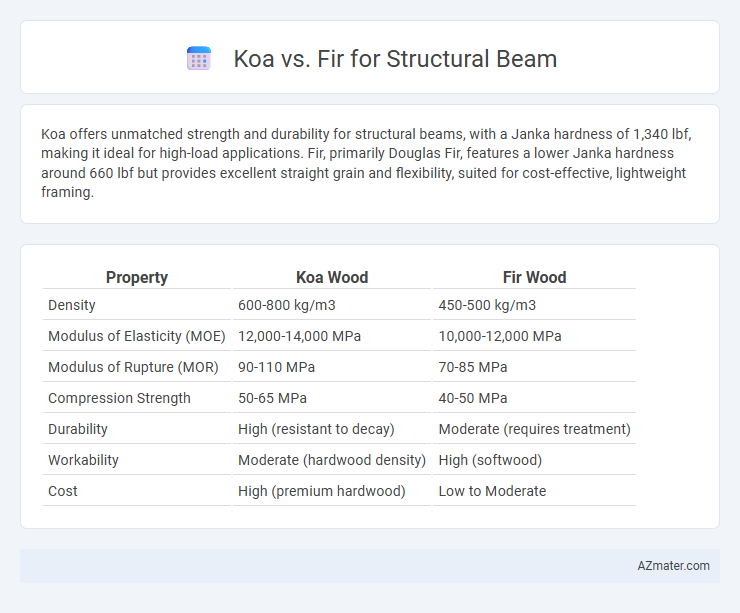Koa offers unmatched strength and durability for structural beams, with a Janka hardness of 1,340 lbf, making it ideal for high-load applications. Fir, primarily Douglas Fir, features a lower Janka hardness around 660 lbf but provides excellent straight grain and flexibility, suited for cost-effective, lightweight framing.
Table of Comparison
| Property | Koa Wood | Fir Wood |
|---|---|---|
| Density | 600-800 kg/m3 | 450-500 kg/m3 |
| Modulus of Elasticity (MOE) | 12,000-14,000 MPa | 10,000-12,000 MPa |
| Modulus of Rupture (MOR) | 90-110 MPa | 70-85 MPa |
| Compression Strength | 50-65 MPa | 40-50 MPa |
| Durability | High (resistant to decay) | Moderate (requires treatment) |
| Workability | Moderate (hardwood density) | High (softwood) |
| Cost | High (premium hardwood) | Low to Moderate |
Introduction to Koa and Fir for Structural Beams
Koa and fir are commonly used woods for structural beams due to their strength and durability. Koa, prized for its dense grain and natural resistance to decay, offers excellent load-bearing capacity and aesthetic appeal in construction. Fir, particularly Douglas fir, is favored for its consistent strength-to-weight ratio and resilience, making it a reliable choice for structural support in buildings and bridges.
Botanical and Material Characteristics
Koa (Acacia koa) is a highly prized hardwood native to Hawaii, characterized by its rich golden to reddish-brown heartwood with interlocked grain, providing a blend of strength and aesthetic appeal ideal for decorative structural beams. Fir, specifically Douglas Fir (Pseudotsuga menziesii), is a softwood known for its straight grain, light color, and high strength-to-weight ratio, making it a popular choice for structural beams requiring durability and flexibility. While Koa offers superior hardness and natural resistance to decay, Fir excels in dimensional stability and is more widely available, influencing their selection in construction based on both botanical source and material performance.
Strength and Load-Bearing Capacity
Koa wood exhibits high density and natural hardness, providing excellent strength and superior load-bearing capacity compared to many other hardwoods, making it suitable for structural beams in demanding construction projects. Fir, particularly Douglas Fir, is known for its exceptional strength-to-weight ratio and consistent load-bearing performance, often preferred in structural applications due to its uniform grain and resistance to bending. While Koa offers greater durability and aesthetic value, Fir's engineered reliability and strength make it a cost-effective, widely used choice for structural beams in residential and commercial buildings.
Durability and Resistance to Decay
Koa wood offers excellent durability and moderate resistance to decay, making it a popular choice for structural beams in tropical environments where moisture and insects are prevalent. Fir, particularly Douglas fir, exhibits strong resistance to decay with natural preservatives but requires treatment in wet conditions to maintain longevity. Both woods perform well structurally, but koa's natural oils enhance its resistance to rot compared to untreated fir.
Workability and Ease of Construction
Koa wood offers exceptional workability for structural beams due to its fine grain and moderate hardness, allowing precise cuts and smooth finishes with standard tools. Fir beams provide ease of construction with their lightweight nature and straight grain, facilitating quicker handling and installation on-site. Both woods balance strength and workability, but fir's uniformity often reduces labor time compared to koa's dense, more resistant fibers.
Environmental Impact and Sustainability
Koa wood, known for its rapid growth in Hawaii, offers a renewable option with moderate carbon sequestration, but its limited regional availability can contribute to environmental strain due to transportation emissions. Fir, widely grown in managed forests across North America, benefits from extensive sustainable forestry certifications, promoting responsible harvesting and lower ecological footprints. Fir's fast growth rate and efficient carbon absorption make it a more sustainable choice for structural beams when considering large-scale environmental impact.
Cost Comparison and Availability
Koa wood for structural beams generally commands a higher price due to its limited availability and premium quality, making it a costly choice compared to fir, which is widely available and more affordable. Fir, particularly Douglas fir, is known for its excellent structural strength and is commonly used in construction, offering cost-effectiveness and easier sourcing. The price disparity between koa and fir can be significant, with koa's rarity driving up costs, while fir's abundant supply ensures lower and more stable prices.
Aesthetic Qualities and Finishing Options
Koa wood offers rich, warm tones with intricate grain patterns that enhance the aesthetic appeal of structural beams, making them a popular choice for high-end architectural designs emphasizing natural beauty. Fir provides a more uniform, light-colored appearance that can be easily stained or painted, offering versatile finishing options to match various interior styles. Both woods allow for smooth finishes, but Koa's natural luster reduces the need for heavy coatings, while Fir's porosity accommodates a wider range of sealants and paints.
Common Applications in Modern Construction
Koa wood, known for its exceptional strength-to-weight ratio and natural resistance to decay, is commonly used in bespoke residential beams and high-end retail interiors where aesthetic appeal and durability are essential. Fir, prized for its straight grain and consistent structural integrity, is widely favored in commercial and industrial construction for framing and load-bearing applications due to its availability and cost-effectiveness. Both woods play significant roles in modern construction, with Koa often selected for architectural features that blend strength with luxury, while Fir dominates large-scale projects requiring reliable, engineered support beams.
Summary: Choosing Between Koa and Fir
Koa offers superior strength and a striking grain pattern, making it ideal for premium structural beams where aesthetics and durability are paramount. Fir provides excellent dimensional stability and is more cost-effective, often chosen for large-scale construction projects that require reliable support without premium pricing. Selecting between Koa and Fir depends on budget constraints, desired appearance, and the specific structural demands of the project.

Infographic: Koa vs Fir for Structural Beam
 azmater.com
azmater.com